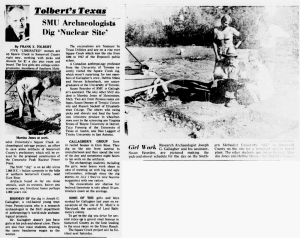
SMU’s Department of Anthropology was founded by Fred Wendorf, a pioneer in what was known in the 1950s and 1960s as “salvage archaeology” — better known today as cultural resource management archaeology. Not long after arriving at SMU, Fred hired Edward Jelks into the department. Under Jelks, SMU faculty and students began conducting archaeological projects for the National Park Service and Smithsonian Institution’s River Basin Surveys under the auspices of the SMU Texas Archaeological Salvage Program.
Jelks left SMU in 1968, and directorship of the salvage program passed to James V. Sciscenti, a colleague of Wendorf’s from his work in New Mexico. After funding for the River Basin Surveys program ended, the salvage program at SMU transitioned into the Archaeology Research Program (ARP). Sciscenti left SMU in 1973 and S. Alan Skinner (Ph.D., SMU 1974) was appointed director of the program. ARP was later directed by L. Mark Raab (Ph.D., ASU, 1976), James Bruseth (Ph.D., SMU, 1987), Randall Moir (Ph.D., SMU, 1997), and in the last few years of its existence by James Adovasio.

The ARP conducted several hundred archaeological projects during its operation at SMU, including projects in Texas, New Mexico, Louisiana, California, and even in Ecuador. These projects included many of the major north Texas reservoirs, the construction of the Dallas Area Rapid Transit rail system, the expansion of the Texas State Capitol, and the ill-fated Super Collider near Waxahachie.
In 1993 SMU administration divested itself of ARP and discontinued its involvement in cultural resource management archaeology. Many of the projects begun at SMU in the late 1980s and early 1990s were completed under the auspices of the ARP at SMU and Mercyhurst College, or simply the ARP at Mercyhurst.

Between 1967 and 1993, archaeological salvage work at SMU was supported by grants and contracts from the National Science Foundation, the U.S. Forest Service, the U.S. National Park Service, the U.S.D.A. Soil Conservation Service, the U.S. Army Corps of Engineers, the Bureau of Reclamation, and the General Services Administration.
Today, SMU’s Archaeology Research Collections serves as the steward of archaeological artifacts, records, and data generated by over 25 years of archaeological work in north Texas by the Archaeological Salvage Program and the Archaeology Research Program at SMU.
Click here to explore scientific publications produced by the Archaeology Research Program at SMU.